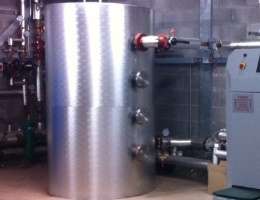This page is outdated ∞ See our new page on buffer vessels HERE
Accumulator Tank SizingA buffer vessel or thermal store, captures heat to provide a buffer between load variations in order that biomass boiler appliance efficiency can be optimised, thus alleviating slow response issues.
A buffer effectively prevents cycling of the boiler when the system demand is less than the boiler minimum output. Reducing boiler cycling is important to minimise harmful emissions of CO and NOx.
Tanks are sized between 10 and 20 litres/kWth plant capacity (CTG012); a lower value may be used where loads do not not fall to zero, for pellet fuelled boilers which are more responsive and for boilers with a low turndown capability.
Where low grade wood with a high moisture content is used, the storage volume may need to be sized at up to 40 litres/kWth.
Quick Definitions
| Accumulator Tank: | A buffer vessel or thermal store |
| Buffer vessel: | A vessel that captures residual heat on boiler shut-down preventing frequent boiler start-ups to improve system efficiency. It will also reduce the energy required from an auxiliary boiler. Usually has a simple on/off control strategy. |
| Thermal Store: | A vessel that is charged by the biomass boiler when the boiler output exceeds the load demand enabling a small biomass boiler to meet demand. A progressive control strategy using several temperature sensors will control the boiler output. |
Other Examples
Also see buffer vessel sizing in the Carbon Trust tool for biomass boiler sizing ![]()


